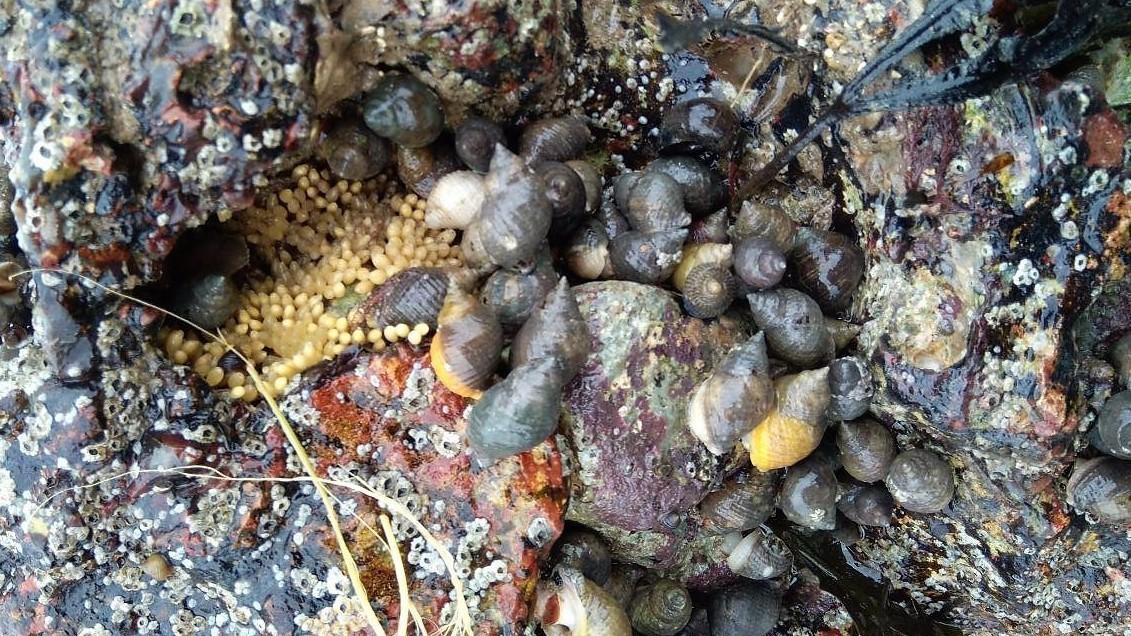
Submitted by Dr C.M. Martin-Jones on Mon, 18/07/2022 - 09:56
Climate change is threatening marine species and ecosystems with rising temperatures and extreme weather. Now scientists from Cambridge and the Royal Belgian Institute of Natural Science have observed how sea snails living on rocky shores are coping with climate change, through studying 130 years of data from dog whelk shells.
As the level of carbon dioxide in the atmosphere rises it is absorbed by the oceans — causing pH levels to fall. This process, known as ocean acidification, is potentially disastrous for shellfish because they find it increasingly difficult to build the shells that protect them from predators.
The new study, published in Nature Communications Earth and Environment, has matched climate driven changes over the last century to changing shell characteristics of dog whelks from museum collections.
Contrary to global predictions for the dog whelk, the team found that the species actually increased its shell thickness over this time period — an adaption that could mean it can cope more favourably with ongoing warming and ocean acidification than had been thought.
“Our findings show that local environmental conditions can provide favourable conditions in which populations could live successfully over the last century, despite ongoing environmental change around them,” said lead-author Dennis Mayk, who is jointly affiliated between Cambridge’s Department of Earth Sciences and the British Antarctic Survey.
The dog whelk is carnivorous; feeding mainly on mussels and barnacles it regulates species numbers lower down the food chain. Any change in size and abundance of the dog whelk could therefore unbalance the shoreline ecosystem with cascading impacts to other species.
Shellfish like the dog whelk are thought to be particularly at-risk from ocean warming and acidification. But scientist’s current understanding of their future is based mainly on short-term experiments ranging from a few days to years.
According to Mayk, these conventional experiments often fail to replicate the true complexity of natural ecosystems, “In reality local environmental factors can mix with warming and ocean acidification in unpredictable ways – leading to unexpected organism responses like the ones we see have seen here from the dog whelk.”
The team, which included Prof. Liz Harper from Cambridge Earth Sciences, used archival museum specimens collected from the Belgian and Dutch coast since the 1888 to get a long-term view on changing shell thickness and shape and their relationship to environmental change, including ocean warming and storminess.
“Our models revealed a significant correlation between temperature and shell thickness,” said Mayk. Sea surface temperatures have increased by 2oC over the last 130 years in the southern North Sea. Mayk explains that these higher temperatures can lead to enhanced growing and foraging conditions for the dog whelk, meaning they are able to grow thicker shells.
Increasing sewage and fertilizer runoff into the sea since the 1960s might also be the cause of the shell thickening, because it can increase food supplies for the dog whelk, explains Mayk. The team also notes that enhanced wave energy, resulting from stormy conditions, might be responsible for the shell changes — but they caution that more data are needed to test this.
“Predictions of climate change outcomes for local marine habitats or communities are extremely challenging,” said Mayk, “Emerging evidence from the scientific community suggests that the structure of marine communities and ecosystems around the world will be impacted significantly by warming and ocean acidification.” Decades, if not centuries, of environmental change can be layered on top of each other at a particular site, meaning it can be even more tricky to tie specific responses to a cause.
For this reason, Mayk calls for a change in the methods used for predictions under warming scenarios, “Studies like ours show that long-term records from museums collections can be useful in ground-truthing global models that cannot anticipate local impacts.”
Mayk, D., Peck, L.S., Backeljau, T. and Harper, E.M., 2022. Shell thickness of Nucella lapillus in the North Sea increased over the last 130 years despite ocean acidification. Communications Earth & Environment, 3(1), pp.1-12.
